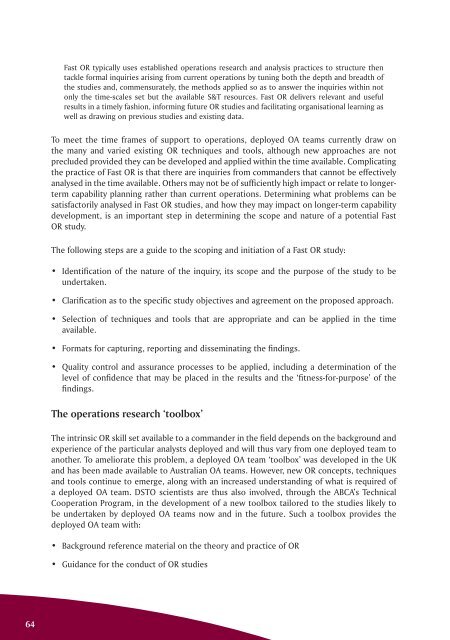ISSUE 182 : Jul/Aug - 2010 - Australian Defence Force Journal
ISSUE 182 : Jul/Aug - 2010 - Australian Defence Force Journal
ISSUE 182 : Jul/Aug - 2010 - Australian Defence Force Journal
You also want an ePaper? Increase the reach of your titles
YUMPU automatically turns print PDFs into web optimized ePapers that Google loves.
Fast OR typically uses established operations research and analysis practices to structure thentackle formal inquiries arising from current operations by tuning both the depth and breadth ofthe studies and, commensurately, the methods applied so as to answer the inquiries within notonly the time-scales set but the available S&T resources. Fast OR delivers relevant and usefulresults in a timely fashion, informing future OR studies and facilitating organisational learning aswell as drawing on previous studies and existing data.To meet the time frames of support to operations, deployed OA teams currently draw onthe many and varied existing OR techniques and tools, although new approaches are notprecluded provided they can be developed and applied within the time available. Complicatingthe practice of Fast OR is that there are inquiries from commanders that cannot be effectivelyanalysed in the time available. Others may not be of sufficiently high impact or relate to longertermcapability planning rather than current operations. Determining what problems can besatisfactorily analysed in Fast OR studies, and how they may impact on longer-term capabilitydevelopment, is an important step in determining the scope and nature of a potential FastOR study.The following steps are a guide to the scoping and initiation of a Fast OR study:• Identification of the nature of the inquiry, its scope and the purpose of the study to beundertaken.• Clarification as to the specific study objectives and agreement on the proposed approach.• Selection of techniques and tools that are appropriate and can be applied in the timeavailable.• Formats for capturing, reporting and disseminating the findings.• Quality control and assurance processes to be applied, including a determination of thelevel of confidence that may be placed in the results and the ‘fitness-for-purpose’ of thefindings.The operations research ‘toolbox’The intrinsic OR skill set available to a commander in the field depends on the background andexperience of the particular analysts deployed and will thus vary from one deployed team toanother. To ameliorate this problem, a deployed OA team ‘toolbox’ was developed in the UKand has been made available to <strong>Australian</strong> OA teams. However, new OR concepts, techniquesand tools continue to emerge, along with an increased understanding of what is required ofa deployed OA team. DSTO scientists are thus also involved, through the ABCA’s TechnicalCooperation Program, in the development of a new toolbox tailored to the studies likely tobe undertaken by deployed OA teams now and in the future. Such a toolbox provides thedeployed OA team with:• Background reference material on the theory and practice of OR• Guidance for the conduct of OR studies64

















